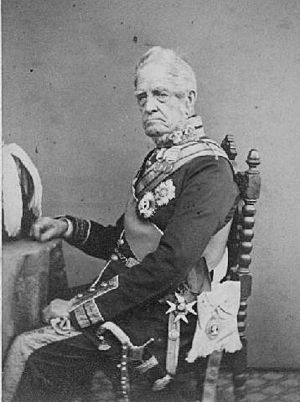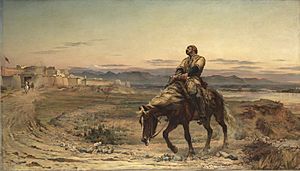Sir George Pollock, 1st Baronet facts for kids
Quick facts for kids
Sir George Pollock, Bt
|
|
|---|---|

Sir George Pollock
|
|
| Born | 4 June 1786 Piccadilly, London |
| Died | 6 October 1872 (aged 86) Walmer, Kent |
| Allegiance | |
| Service/ |
|
| Years of service | 1801–1846 |
| Rank | Field Marshal |
| Battles/wars | Second Anglo-Maratha War Anglo-Nepalese War First Anglo-Burmese War First Anglo-Afghan War |
| Awards | Knight Grand Cross of the Order of the Bath Knight Grand Commander of the Order of the Star of India |
| Relations | Sir Frederick Pollock, 1st Baronet (brother) |
| Other work | Constable of the Tower |
Sir George Pollock was a very important officer in the British Indian Army. He was born on June 4, 1786, and passed away on October 6, 1872. He became a Field Marshal, which is the highest rank in the army.
Pollock fought in several major wars. These included the Second Anglo-Maratha War, the Anglo-Nepalese War, and the First Anglo-Burmese War. He is perhaps best known for his actions during the First Anglo-Afghan War. After a terrible retreat from Kabul in 1842, many British forces were trapped. Pollock led a mission to rescue them and bring them to safety. His bravery and leadership were recognized with a special medal named after him.
Contents
Sir George Pollock's Life
Early Years and School
George Pollock was born in Piccadilly, London. His father, David Pollock, was a saddler (someone who makes saddles) for King George III. George had an older brother, Sir Frederick Pollock, 1st Baronet, who became a famous lawyer.
George went to the Royal Military Academy, Woolwich. This was a special school where young people learned to become army officers. He joined the Bengal Artillery, a part of the British Indian Army, in 1803.
Military Career
Fighting in India and Nepal
George Pollock quickly rose through the ranks. He became a lieutenant in 1804. He fought in the Battle of Deeg and the Siege of Bhurtpore. These battles were part of the Second Anglo-Maratha War.
Later, he became a captain and served in the Anglo-Nepalese War. He was promoted to major in 1819. He then became an important officer in the artillery, which handles large guns.
Wars in Burma
After some time off due to illness, Pollock returned to lead the British artillery. He commanded the big guns at the Battle of Prome in 1824. He also led forces at Bagan in 1826. These battles were part of the First Anglo-Burmese War.
For his service, he received an award called the Companion of the Order of the Bath. He continued to be promoted, becoming a colonel and then a major-general.
The Afghan War
In 1838, the British decided to invade Afghanistan. This started the First Anglo-Afghan War. At first, things went well. But by the end of 1841, the situation became very dangerous. British leaders decided to pull their troops out of Kabul.
The retreat in January 1842 was a disaster. Thousands of soldiers and civilians died from the cold and attacks. Only a few survived. Many British officers, soldiers, and families were captured.
Pollock was chosen to lead a force to rescue the trapped British soldiers at Jalalabad. He bravely led his troops through the difficult Khyber Pass. In April 1842, he successfully reached and rescued the garrison.
Pollock then decided to do something extra. He wanted to rescue the British hostages left behind in Kabul. He joined forces with another general, William Nott. After more battles, Pollock's forces reached Kabul in September 1842. He rescued the hostages and then returned to India.
For his great achievements, Pollock was given an even higher award. He became a Knight Grand Cross of the Order of the Bath. In 1844, a special award was created in his honor. The Pollock Medal was given to the best student at the Addiscombe Military Seminary.
Later Life and Achievements
After returning to England in 1846, Sir George Pollock received a yearly payment. He continued to serve in important roles. He was promoted to lieutenant general and then to full general.
He received more honors, including the Knight Grand Commander of the Order of the Star of India. In 1870, he reached the highest military rank: Field Marshal.
In 1871, he became the Constable of the Tower, a very old and respected position. He was also made a baronet in 1872. Sir George Pollock passed away on October 6, 1872, and was buried in Westminster Abbey.
Family
Sir George Pollock married Frances Webbe Barclay in 1810. They had four sons and one daughter. His eldest son, Frederick, inherited his title. His second son, George David Pollock, became a famous surgeon. Sadly, his third son, Robert, died in battle in 1845. After his first wife passed away, he married Henrietta Wollaston in 1852.



